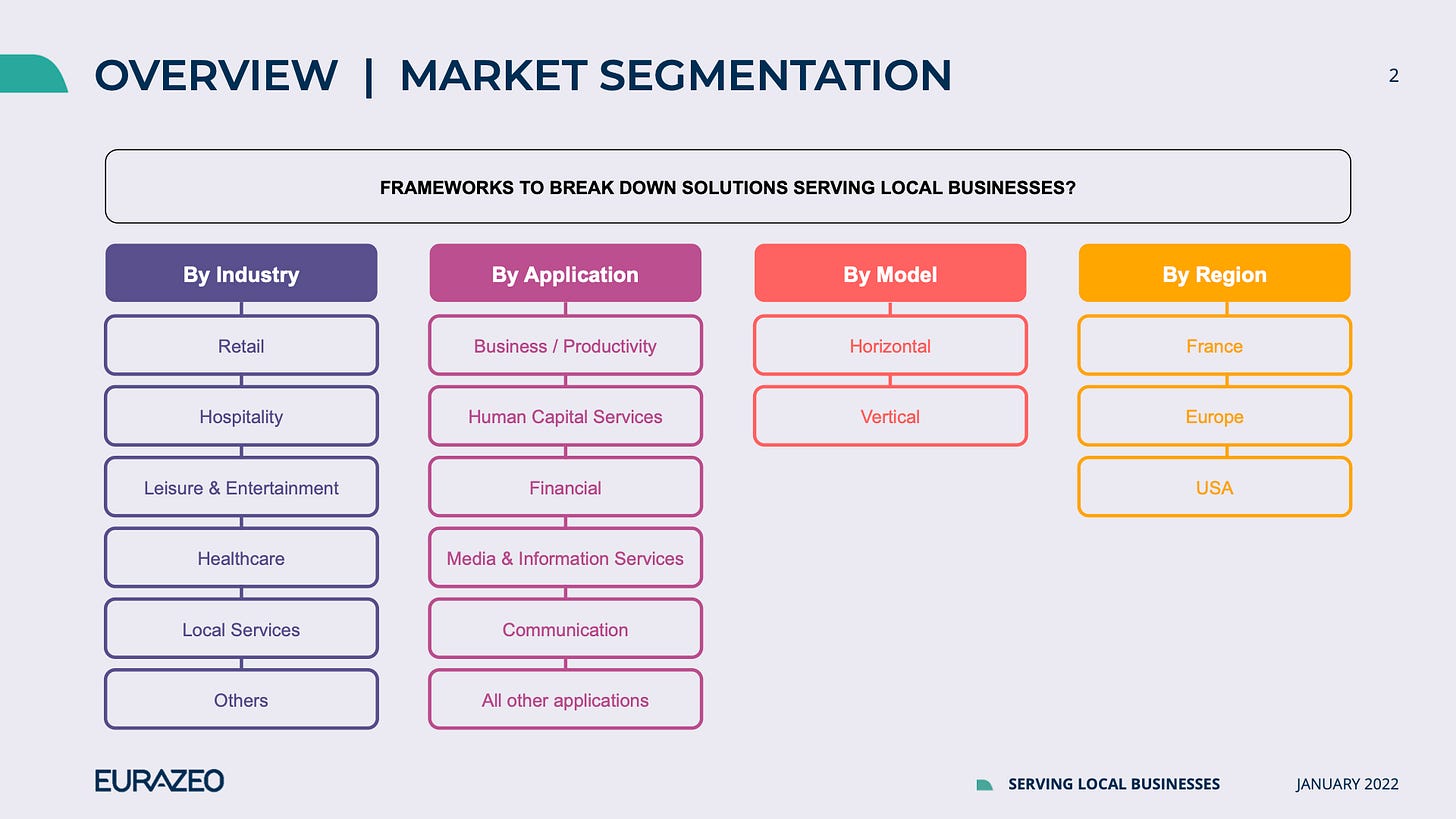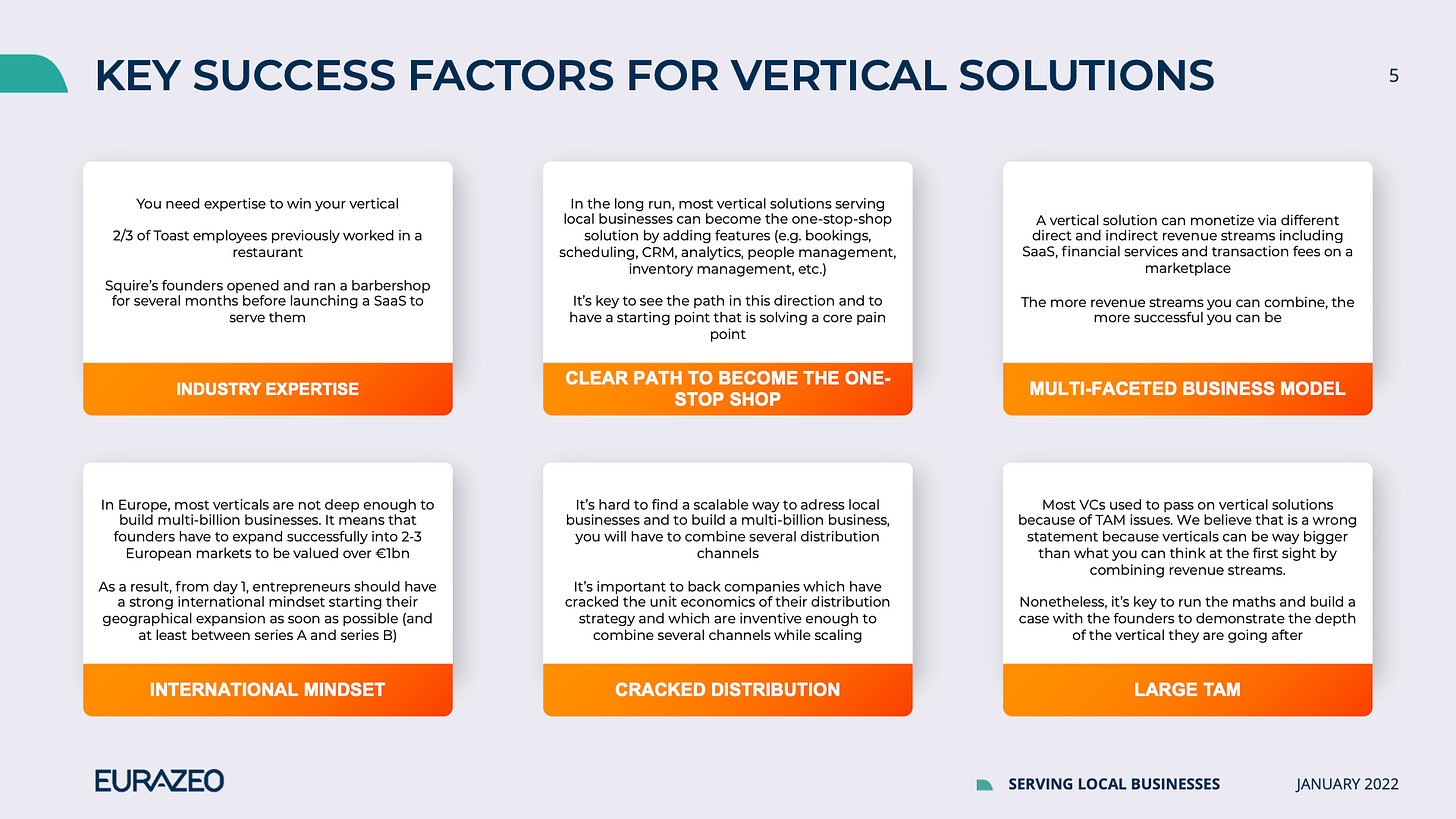🛖Why Should you Build a Vertical SaaS for Local Businesses?
Overlooked #106
Hi, it’s Alexandre from Eurazeo (ex. Idinvest). I’m investing in seed & series A consumer and consumer enablers startups all over Europe. Overlooked is a weekly newsletter about venture capital and underrated consumer trends. Today, I’m sharing why I like vertical SaaS for local businesses and what are the key success factors that we’re looking at when evaluating startups in this space.
This paper is part of a broader deep-dive that we’ve been working on with Clément and Loup on vertical SaaS & marketplaces for local businesses.
In the past couple of months, we’ve seen an increasing number of early stage entrepreneurs building SaaS for local businesses in our deal-flow. In parallel, we noticed that vertical SaaS companies such as Doctolib (healthcare), Toast (restaurants) or Procore (construction) were becoming multi-billion dollar companies.
We took the time to carefully study these models to understand what makes them appealing for investors. We concluded that (i) vertical SaaS were superior to horizontal ones to serve local businesses and that (ii) we should look at specific key success factors while evaluating these companies.
I divided this post sharing these learnings into 3 sections:
Why vertical SaaS are strictly superior to horizontal ones to serve local businesses?
Why now? Why vertical SaaS for local businesses are particularly interesting in 2021?
What does it take to be successful when you build a vertical SaaS for local businesses?
Why vertical SaaS are strictly superior to horizontal ones to serve local businesses?
I believe that for local businesses, verticalized SaaS are strictly superior to horizontal ones because verticalized players can become the global OS of the industry they target - which is something that horizontal SaaS will never achieve.
I like vertical SaaS for the following reasons:
Superior products: vertical SaaS will customize every feature to the industry they serve (e.g. Doctolib's booking platform allowing patients to share data related to their health) and will build specific features that only make sense for the vertical targeted (e.g. Amenitiz including a property management system in its SaaS for hotels).
Higher market penetration potential: it's hard to impossible to reach market dominance as an horizontal SaaS. You will always have CRM (Salesforce, Hubspot, Pipedrive) or communication tools (Slack, Teams, Discord) competing. On the contrary, well-executed vertical SaaS are becoming industry standard and can reach market share above 50%. Some vertical SaaS will become SaaS-enabled-marketplaces to incorporate network effects in their model in order to reach market dominance (e.g. Mindbody's successful booking platform for consumers is a strong value proposition to sign new beauty professionals).
More efficient acquisition machine: as you are serving an unique vertical, your sales team has a deeper knowledge of the pain points that your product is solving. You can have a super relevant sales pitch to potential customers that will increase conversion rates. After a certain threshold, vertical SaaS also see the market tipping in their direction with more customers coming organically or customers easily convinced because of your growing reputation. Moreover, you can implement acquisition strategies uniquely suited for your industry (e.g. going to a trade faire for your vertical, partnering with influencers in this vertical etc.).
Strong TAM expansion potential: historically, most investors were passing on vertical SaaS because the addressable market was too small. Nowadays, this statement is wrong for most verticals. Vertical SaaS have a clear playbook to massively increase their addressable market by (i) becoming the one stop shop software for their industry, (ii) building marketplaces (consumer facing, developer facing or supplier facing) and (iii) tying financial services to their offering (e.g. Mews processing payments when end consumers book a room in one of its hotels).
The OS of a given industry: vertical SaaS have the potential to become the one stop shop solution for professionals in a given vertical to manage all the aspects of their business. When you become the backbone of your customers, your solution can drive high engagement rate and low churn rate. I believe that it's a great position to be into when you are the last software that your customers will unplug before closing down their business.
Why now? Why vertical SaaS for local businesses are particularly interesting in 2021?
With Covid, the ineluctable digital transformation is accelerating across industries - even in the most old-fashioned ones. Covid has also opened specific business opportunities for new vertical SaaS creating a unique “why now” moments (e.g. Sunday leveraged the democratization of QR-codes thanks to sanitary passes to build a new payment system for restaurants).
Venture investors stopped to pass on vertical SaaS because of TAM concerns. They understand that these businesses can expand their market significantly and are reassured by multi-billion dollar successes like Lightspeed, Toast, Mindbody or Procore.
It has become easy to embed financial services into your vertical SaaS because infrastructure players have become mature (e.g. Stripe for payments and capital, Check for payroll, etc.).
What does it take to be successful when you build a vertical SaaS for local businesses?
If TAM no longer scares investors, it remains a topic that you need to proactively address to prove that you are in a space in which you can build a venture-scale business (dig into sub-verticals in a category, look at adjacent categories, estimate the ACV at scale with expansion as one-stop-shop/marketplaces/financial services).
On positioning, you need to start with a product that is business critical for your industry and quickly evolve towards becoming the system of record / the backbone of your customers.
You need to have a good "why now" reason in the vertical you are disrupting and I'm not sure that replacing pen & paper as well as on-premise software is a sufficiently strong “why now”.
On founders, I would value people with (i) a deep knowledge of their vertical and (ii) the mental plasticity needed to adapt theirs plans to expand. For European vertical SaaS, I also value entrepreneurs who have a strong international mindset. It’s impossible to build a multi-billion dollar vertical SaaS for local business while only serving one European country. It's important to start internationalisation quite early on - either opening several European countries or expanding in the US market.
On distribution, I'm not sure that you can scale only with an outbound sales machine. You need to have one or several distribution's tricks / moats to be successful.
Thanks to Clément, Loup and Julia (🦒) for the feedback! Thanks for reading! See you next week for another issue! 👋



